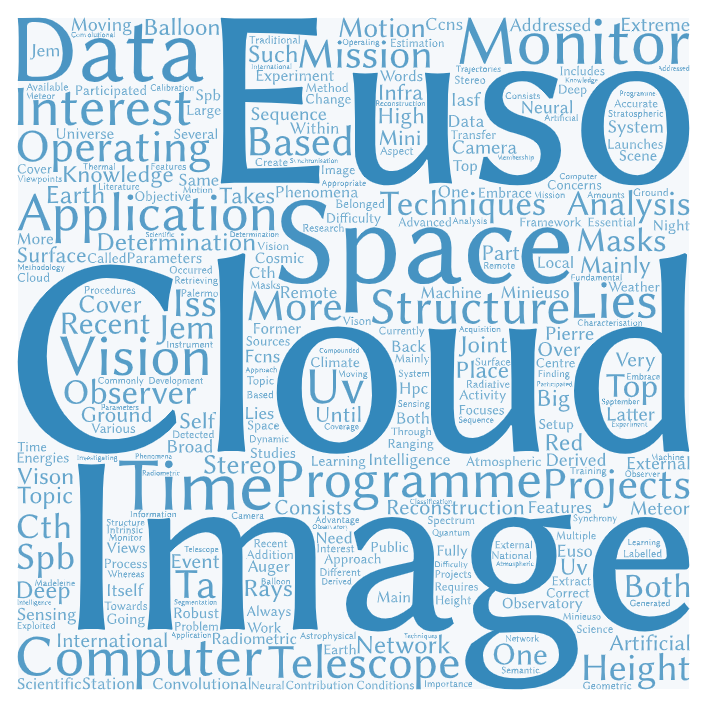


Researcher
phone: +39 091 6809 476 (direct)
fax: +39 091 6882 258
email: anna.anzalone@inaf.it
Main scientific interests: Computer Vision, 3D Reconstruction, Remote Sensing, Artificial Intelligence, Deep Learning
Projects: JEM-EUSO, HPC, Big Data and Quantum Computing, MADELEinE
My scientific interest lies mainly in computer vision and its applications, that embrace remote sensing, stereo vison, structure from motion, image sequence analysis, and development and application of advanced artificial intelligence techniques.
My activity takes place within the framework of international projects such as, the JEM-EUSO (Joint Experiment Missions for Extreme Universe Space Observatory) programme to which I have belonged since 2007 and the Pierre Auger Observatory in which I participated until 2014. Both have as their objective the observation of cosmic rays of very high energies, from space the former and from the ground the latter. My contribution mainly concerns the analysis of atmosphere monitoring data. The determination of cloud cover, its characterisation and height estimation are topics of interest for a broad spectrum of applications, ranging from astrophysical projects for the observation of phenomena in space, to studies of climate change and monitoring of the Earth’s surface.
JEM-EUSO programme
Atmosphere Monitoring – Meteor tracking
The program consists of several operational projects: the ground-based telescope (EUSO-TA), stratospheric balloon launches: EUSO-Balloon, EUSO-SPB1, EUSO-SPB2, the Mini-EUSO telescope, currently operating on the International Space Station (ISS), and the K-EUSO space mission. For most of its missions, the programme includes an infra-red camera to monitor weather conditions in time synchronisation with the night-time operation of the various UV telescopes. Cloud-top height (CTH) determination and the knowledge of the cloud cover at the same time as the phenomena occurred are essential for the correct reconstruction of the event.

CTH retrieval
3D cloud top height retrieval with stereo vision techniques is one of my focuses. The advantage of using this methodology over the more commonly used ones based on radiative transfer, lies in the self-consistency of the method itself. In other words, for the more traditional procedures, in addition to accurate radiometric calibration, it is of fundamental importance to have knowledge of atmospheric parameters derived from sources external to the acquisition instrument, which are not always available in time and local synchrony. Stereo CTH reconstruction, requires an appropriate setup of the system and the knowledge of its geometric parameters, intrinsic camera features and a robust image analysis system, but no externally derived information.
Cloud masking
The monitoring of cloud coverage needs the reconstruction of the so-called “cloud masks”, in which image pixels are classified as cloudy/not cloudy areas and in some cases also the type of cloud is determined. The problem has been addressed in the literature with both radiometric and computer vision approaches. But the use of machine and deep learning techniques for the segmentation and classification of cloud images is of more recent application. The main difficulty, however, is the need for large amounts of labelled data for network training, compounded by the difficulty of finding masks that are in public use. To overcome these difficulties, automatic or semi-automatic labelling processes can be exploited. My recent activity is oriented in finding efficient methods to improve the applicability of deep learning and the accuracy of the resulting masks.


Meteor 3D tracks
Meteors are one of the space phenomena observed by the MiniEUSO UV telescope. 3D reconstruction of their trajectories can provide valuable insights into the behavior of meteoroids in Earth’s atmosphere, enabling better understanding of their origin and properties.


My objective is using structure from notion techniques. In computer vision they are applied to obtain a 3D scene from sequences of images generated from the different viewpoints of an observer (in our case MiniEUSO), moving through the dynamic scene (the meteor moving towards the Earth’s surface).
I’m also member of the National Research Centre for HPC, Big Data and Quantum Computing (September 2022) programme and the data science and artificial intelligence programme, MADELEinE (MAchine and DEep LEarning in Experiments).
MADELEinE is a research program of the IASF Palermo, that focuses on the application of Artificial Intelligence methods not only in astrophysics frameworks but also in image analysis and computer vision fields.